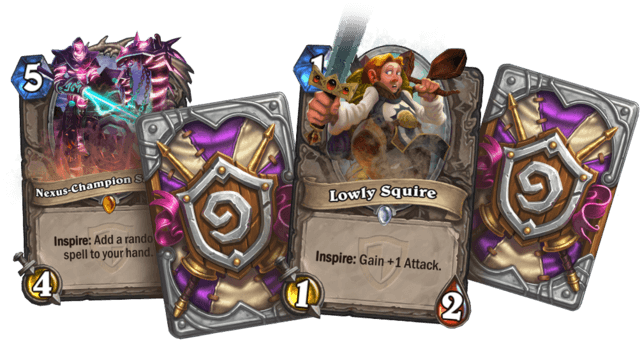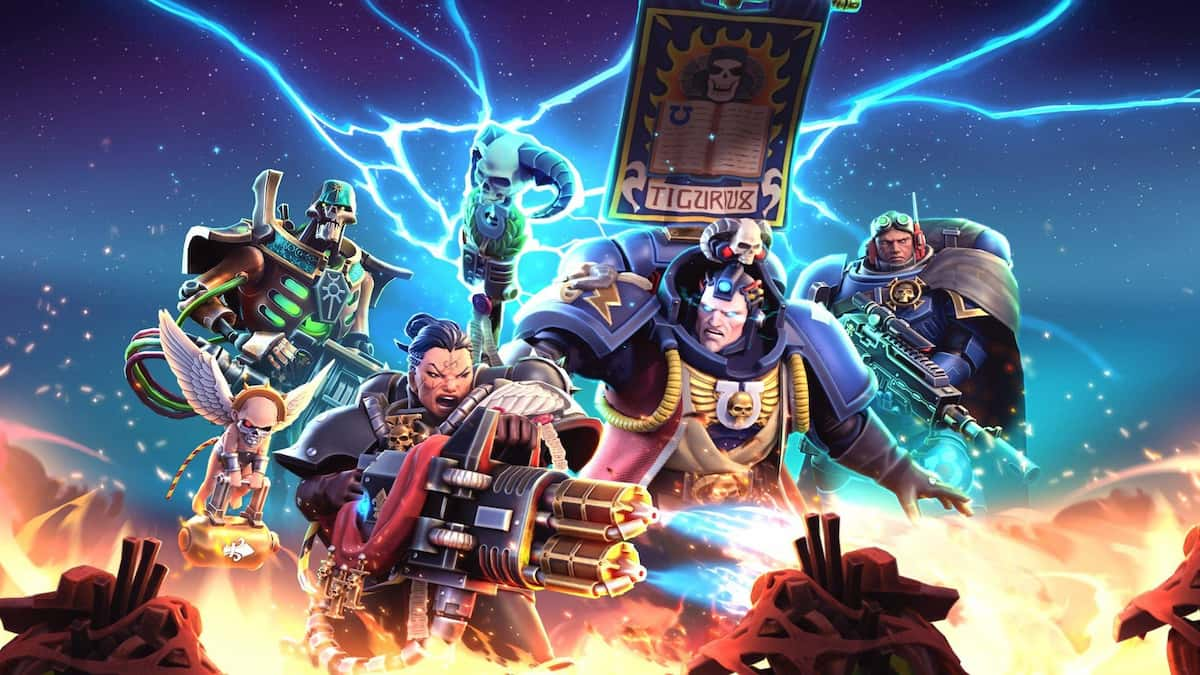Hearthstone‘s newest expansion is finally here, bringing with it over 120 new cards and several new mechanics, including several that relate to your hero power. While it’s definitely going to take a while to figure out the overall impact of this deck on the meta as a whole, and constructed will probably be in a state of flux for a while, it’s definitely safe to say that The Grand Tournament has shaken up the arena game more than a little.
The Inspire mechanic, while of questionable usefulness in constructed, has the potential to seriously impact the arena, and the addition of several higher health Commons has reduced the impact of certain removal spells and previously high-value cards. Check out our detailed Tier List and class explanations to find out exactly how the game has changed.
Get Inspired

The key mechanic of The Grand Tournament is called Inspire, and it’s pretty simple — certain cards will give benefits when you use your hero power. Some give your cards buffs, others boost your power, and some even summon more minions. In constructed play, this is a difficult mechanic to take full advantage of because of how slow it is, and you need to build a deck specifically around it, but in the arena, even with a really well drafted deck, your hero power is going to get used, making this potentially very useful.
There is also the Joust mechanic — when you play or draw certain cards, you reveal a card and compare its cost to your opponent’s revealed card. If yours costs more, you get an extra benefit. This is less useful than in constructed, but it can help players who want to build arena decks with a higher curve or who get lucky with big minions.
Some classes have come out better than others with these changes. Here are the big winners and losers.
Tier One
There have been some interesting changes in the top tier of the arena. The higher number of overall cards means that the Mage is no longer guaranteed to draw their high-powered removal and other classes, notably the Rogue, have gotten buffs that bring them in line with the previous kings of the arena.
Mage
 Mages are still at the top of the rankings, if for no other reason than their hero power keeps them there. Flamestrikes are harder to come by and there are a lot more minions that can survive them, making a Mage’s most powerful arena tool a lot less potent. It might be that the Mage gets overtaken by the Paladin or the Rogue, but Flamestrike is still one of the best arena class cards in the game.
Mages are still at the top of the rankings, if for no other reason than their hero power keeps them there. Flamestrikes are harder to come by and there are a lot more minions that can survive them, making a Mage’s most powerful arena tool a lot less potent. It might be that the Mage gets overtaken by the Paladin or the Rogue, but Flamestrike is still one of the best arena class cards in the game.
None of the mage’s new commons are terribly useful in arena, but Fallen Hero and Polymorph: Boar have the potential to be very powerful if you’re lucky enough to draft them. Coldarra Drake is very powerful with the right inspire cards, but you shouldn’t bank on being able to draw an epic. The best thing the mage has going for it in terms of The Grand Tournament cards are neutral cards like Mukla’s Champion, Fencing Coach, and Silver Hand Regent.
Paladin
Nothing can ever really match the incredible power boost that the paladin got from Shielded Minibot, and The Grand Tournament delivers another excellent common: Murloc Knight has the potential for incredible value. It’s slow, but if it survives long enough for you to use your hero power just once, it can swing the entire board in your favor. It can even summon another Murloc Knight, leading to an insane snowball situation.
The increased value and availability of Silver Hand Recruits also increases the value of Quartermaster and the new Warhorse Trainer — you shouldn’t count on being able to pull off a combo, necessarily, but you can feel comfortable drafting cards that work with your recruits.
Rogue
In a surprising change of pace, the Rogue has become incredibly viable in arena, and may even be the new top class once the stats shake out. Almost every single one of the new Rogue commons and rares is incredible in the arena — Buccaneer is a huge turn one play, and playing Cutpurse makes setting up combos incredibly easy. Shado-Pan Rider is incredible value, and Undercity Valiant is a mini SI:3 that can take out a lot of popular one drops.
The Rogue is currently tearing up the arena rankings — it could be that people are still learning how to deal with the new cards, but it might be that we have a new arena champion. Only time will tell.
Tier Two
Just like Tier One, Tier Two has seen some interesting shifts, though the general power level of the classes hasn’t changed immensely. Druids and Shamans both got some hefty minions to help their arena woes and have seen their fortunes improve as a consequence.
Druid
![]()
Druids have always been a strong arena class, but have been hurt a little by not being able to count on their combo potential. The cards Druids got from The Grand Tournament don’t change anything drastically, but they provide some very powerful early-game drops that can help them survive long enough to drop the large, sticky minions that Druids are famous for.
In terms of commons, while conditional, Wildwalker offers incredible value, and the new Druid of the Saber adds another potentially incredible 2-drop that can trade favorably with a whole range of cards. Living Roots is the real winner here — having the option of a cheap nuke or buffable tokens can be very powerful. Rares are even better — Savage Combatant makes your hero power beastly, and Darnassus Aspirant allows you to easily ramp your power up, especially if you can keep it on the board for a turn or two.
These new cards have boosted the Druid to the top of Tier Two and it may even be pushing Tier One — either way, there’s no doubt that this class is way more viable in the arena than it was before.
Shaman
Shamans have always struggled in the arena, even with powerful drops like Fireguard Destroyer and Fire Elemental, in large part because of their relatively weak early game. Nothing can fully rescue the class from the randomness of its hero power, but some of The Grand Tournament’s cards go a long way toward helping the Shaman survive long enough to get their power rolling.
Tuskar Totemic and Totem Golem are both high-value commons that can help Shamans seize control of the board early and that synergize extremely well with Thunder Bluff Valiant and Draenei Totemcarver. It’s a legendary card, so you can’t count on it, but if you are lucky enough to draft The Mistcaller then you are almost certainly looking at a 7+ arena run.
Shamans are still a little too reliant on rares for board control to be consistent in arena, but The Grand Tournament cards go a long way toward plugging some obvious holes and improving their overall position among the classes.
Warlock
The Warlock has managed to maintain its position in the middle of Tier Two largely because The Grand Tournament hasn’t changed its position very much. The new commons and rares available to the Warlock are interesting, but not game changing, and in some cases a little risky — Demonfuse and Wrathguard are both potentially powerful, but come with significant drawbacks.
Fist of Jaraxxus and Tiny Knight of Evil are good, but depend on circumstances you might not be able to control in the arena. Wilfred Fizzlebang, if you manage to draft him, is incredible value.
The biggest boon to Warlocks is that the Inspire mechanic greatly improves their hero power — the biggest problem with Life Tap is that it doesn’t affect the board, but depending on which minions you have out, it now can make a difference. It’s not enough to bost Warlocks to high Tier Two, but it’s enough to keep them where they are.
Tier Three
For the most part, the bottom tier of the arena has remained the same. Warriors had high hopes for moving up, but the cards just weren’t there, and while there are some great additions from The Grand Tournament for Hunters and Priests, they aren’t terribly viable in the arena.
Hunter
The Hunter actually received some powerful cards that are a great boost to any arena deck — King’s Elekk and Bear Trap are both excellent value for their cost, and Ram Wrangler has serious potential if played correctly.
Unfortunately for the hunter, their biggest strength in both arena and constructed — fast damage and aggression — is harder than ever to take advantage of. The Grand Tournament has added a lot of high-health cards, powerful taunts, and heals, making it more difficult than ever for Hunters to finish games before their opponents get their value-machines rolling.
Priest
Priests received some really powerful cards with The Grand Tournament, some of which have the potential to be incredibly valuable, but none of which fix the underlying problems with the class that keep it from being a serious arena contender.
Power Word: Glory and Holy Champion are both strong cards in the right conditions, and Convert is a really great way to play off your opponent’s strengths. Unfortunately, the Priest is still a little too slow and combo-dependent to be reliable pick.
That being said, if you DO manage to draft a lot of dragons, Twilight Whelp and Wyrmrest Agent are pretty much the best value you can get for their cost — a Priest arena run with the right dragon draws could be devastating.
Warrior
Unfortunately, Warriors are exactly where they’ve always been in terms of the arena. The class is still too dependent on combos and weapon draws to be effective; none of the new cards in The Grand Tournament are enough to fix these flaws. Sparring Partner and Bolster, notably, are really strong cards, but rely on the Warrior having enough minions and taunts to make them valuable.
It is more than possible to get a lot of arena wins with the Warrior, but you’re still working against the design of the class unless you get very lucky with draws.
Closing Thoughts
It’s still a little early to say anything for certain about arena rankings, but it is clear to see that there are some winners and some losers. It will take players a while to figure out how to best use the Inspire mechanic, so we may yet see some changes as Hearthstone adjusts to the addition of this new consideration. Keep up your arena attempts, keep experimenting, and good luck!







Published: Aug 28, 2015 08:03 am